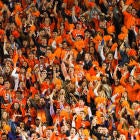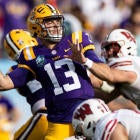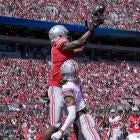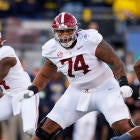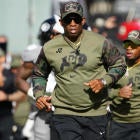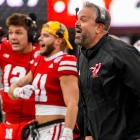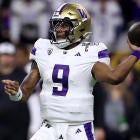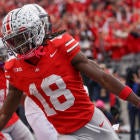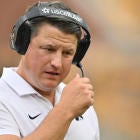College football attendance is at its lowest point in 22 years, and a 34-year-old Virginia Tech administrator has an idea how to goose it.
KISS.
Yes, KISS, the face-painted classic rock band that is on yet another farewell tour fronted by 69-year-old lead singer Gene Simmons.
Brad Wurthman went to his first KISS show at age 11. He was hooked by the music, the pyrotechnics, and -- lately as VT's senior associate athletic director for external relations -- the entire presentation.
"I joke with people, 'This is how I got into the marketing side,'" Wurthman said. "I wasn't an athlete. For me, at least, the fundamental [way] how you run an event is the way KISS runs a show."
Wurthman went to describe the anticipation built by the band's introduction hype video on the jumbotron -- KISS walking from dressing room to stage -- and the same old songs that are the foundation of classic rock radio.
Yeah, they rock the house. They could also lead a morning athletic department staff meeting.
"It is," Wurthman concluded, "quintessential sports marketing."
The drop in football attendance is less of a story these days; the question is whether anything can be done about it. According to preliminary NCAA numbers produced last week, FBS college football attendance was down again -- for the seventh time in the last eight seasons -- to its lowest average mark in 22 years.
The average of 41,856 fans per game for the 129 FBS teams in 2018 was the lowest figure since 1996. That's a year after the average per-school decline was the largest in 34 years.
Of the top 30 schools in 2017 attendance, 20 stayed the same or declined in 2018. Among that top 30, Virginia Tech had the fifth-largest decline, 3,700 fans per game in the 66,233-seat Lane Stadium, behind the likes of USC, Ohio State, South Carolina and Florida.
Even in a national championship season, Clemson was down (slightly -- an average of 373 per game, according to the NCAA's figures).
That made Virginia Tech somewhat of an outlier. The ACC was the only Power Five conference whose average attendance increased in 2018.
The Pac-12, for example, posted its lowest average attendance since 1982. The average per-team decline of 3,013 was the largest among FBS conferences since 2014 when the AAC lost 4,519 per game.
The Big Ten sunk to its lowest average (65,365) since 1993. Conference USA and the Mountain West posted the lowest averages in their history.
For the fifth consecutive year, the majority of the 10 FBS conferences were down in attendance (7 of 10 in 2018). Compare that to 9 years ago when only the then-Pac-10 declined from 2009-10.
| Conference | Avg. Attendance (2018) | Change (from 2017) | Note |
|---|---|---|---|
SEC | 74,185 | -1.2 percent | Lowest since 2003 |
Big Ten | 65,365 | -1.3 percent | Lowest since 1993 |
Big 12 | 56,490 | -0.6 percent | Lowest since 2003 |
ACC | 48,609 | +0.3 percent | |
Pac-12 | 46,588 | -6.1 percent | Lowest since 1982 |
AAC | 28,902 | +0.8 percent | |
MWC | 23,862 | -4.4 percent | Lowest in history |
C-USA | 18,874 | -1.9 percent | Lowest in history |
Sun Belt | 17,396 | -2.5 percent | Lowest since 2007 |
MAC | 15,532 | +0.9 percent |
Overall, FBS was down a mere 347 fans per game -- less than 1 percent overall. But despite the addition of seven FBS programs since 2013, overall national attendance has declined more than 1,427,000 since an all-time high of 38,135,118 fans 5 years ago. Average attendance is down 5,115 per game from an all-time high of 46,971 in 2008.
| Year | Avg. FBS Attendance | Year | Avg. FBS Attendance |
|---|---|---|---|
2008 | 46,971 | 2014 | 44,603 |
2009 | 46,284 | 2015 | 43,933 |
2010 | 46,632 | 2016 | 43,612 |
2011 | 46,074 | 2017 | 42,203 |
2012 | 45,440 | 2018 | 41,856 |
2013 | 45,671 |
Invoking the marketing strategy of KISS suddenly doesn't sound that outrageous when translated to college athletics.
"Winning is not a strategy," said Wurthman, who arrived at Virginia Tech from Illinois in 2017. "That's our general mantra. It's nice to win, but I tell our staff all the time, 'Build the model [because], when coaches catch lightning, we take advantage of it."
College sports marketing -- and interest in the sport as a whole -- is in a state of transition. Players are a pass-through commodity, replaced from year to year. Never mind winning, coaches just sticking around is a bonus. A combined 47 schools changed coaches in the last two seasons. That's 36 percent of the FBS.
Television ratings for college football remain strong.The issue for Alabama on down is administrators figuring out how to keep fans -- particularly students -- coming through the turnstiles.
The thinking goes, if you lose students' attention early while they're in school, that makes it harder to go to students for contributions when they're established in the work force.
School loyalty established in the shared-experience of football fandom risks being lost. South Florida boasted of a 39 percent increase in student attendance (almost 8,000 per game) coming off a 7-5 regular season.
"The reality is that the national attendance numbers are going to continue to go down," Bulls AD Mike Kelly said, "mainly due to the comparative social and leisure experiences that can now be had outside the football stadium even if those experiences still center around the game itself."
The issue doesn't end with students.
"We're competing more than ever before against the television product we helped create," Big 12 commissioner Bob Bowlsby said. "There's no line at the restroom, the beer is always cold [at home]. You don't have to invest 8 hours going to the stadium. There's no parking fees. You don't have to pay seat license, and on your 70-inch TV it's a pretty good viewing experience."
The reasons for attendance drop off are burned into the synapses of college marketers -- lack of in-stadium WiFi, shifting game times, student apathy, ticket prices, the conveniences that Bowlsby mentioned.
The challenge is to make the game more of an experience than a win-lose proposition.
KISS did it by playing those same songs, thereby imprinting that experience. They followed up marketing themselves through a line of action figures, cartoons, even their own "Rock & Brews" chain of restaurants.
"The first time you experience them, it shouldn't be on a record," Wurthman said. "We just have to have a similar mentality. Our value proposition has to be more than football and basketball. It has to be 'Football Plus.'"
Wurthman called the struggle to retain fans' game-day interest an "inflection point" -- a crossroads in college athletics.
"Why it's happening is the magic-bullet question," he said. "I wish that there was some easy answer."
Virginia Tech has traditionally done its part. Wurthman said Hokies' games were sold out from 1998 to 2013. Lane Stadium continues to do its part with that epic "Enter Sandman" pregame introduction. To scores of fans, Metallica's hit relates more to Virginia Tech's brand than the band's.
"If we didn't play that, there would be riots in the street," Wurthman said.
Texas undertook a marketing renovation when AD Chris Del Conte came from TCU in December 2017. It started with the realization that since Mack Brown's departure in 2013, winning couldn't necessarily be counted on as a selling point. Last year, the school lowered the price of 10 core concessions. It introduced alcohol. "Bevo Boulevard" -- a pregame experience featuring music festivals, food trucks and … fun – was added. Bevo himself was paraded down San Jacinto Blvd.
Del Conte even told sponsors their in-game commercials were being limited because they were … boring. That meant telling the local bank president his game-ball presentation at the end of the first quarter wouldn't be needed.
"You know what our fans don't ask for?" said Drew Martin, Longhorns senior executive associate AD for external affairs. "They don't ask for more commercials. We're reminding fans the reason they come to a football game is to reconnect with your alma mater, your friends. It's a big party. We've taken the emphasis out of the on-field result and put it back on, 'You can't get this at home.'"
Wurthman and Martin are highly respected sources on this matter as the top lieutenants for two of the top ADs in the country -- Del Conte and Virginia Tech's Whit Babcock.
Certainly winning had something to do with more butts in seats. The Longhorns put a cherry on their best season in 9 years (10-4) with a Sugar Bowl win over Georgia. As business closed last week, season ticket renewals were at 87 percent.
Texas attendance was up almost 5,000 per game in 2018 to more than 97,000 per game (12th nationally). Last year, Martin followed Del Conte to Texas from TCU. The two had transformed the experience in and around Amon G. Carter Stadium.
"I encourage everybody to do what we've done," Martin said of Texas. "Be very transparent, be very available through social media means, return every phone call, return every email. Listen to your fan base."
He added, "I feel like the Texas fan has felt very distant from their own program."
That's less of an indictment of Texas than of the entire industry. The 'Horns established the "Stadium Stampede," the age-old rite of a team walking through a greeting line of fans. That sort of thing had been going on for decades at Tennessee and Auburn.
"I got a text from one of our coaches going out of the stadium, 'By far the best team walk in the country. Our players are so jacked to play football.' That's the validation you look for," Martin said.
There are asterisks to be attached to this attendance downturn. Since 2012, 10 schools have moved up to the FBS. Those schools typically have smaller stadiums having usually come from the FCS. That is one drag on average attendance.
Another is stadium renovation. There is a push to build smaller stadiums in order to create a premium -- higher demand -- ticket.
That explains USC, which fell off in attendance by more than 17,000 in 2018. The school is in the middle of a renovation that drops capacity from 93,000 to 77,500.
But there is still that big picture. Scores of college stadiums were built during the Great Depression. That makes it doubly hard to wire them for modern-day WiFi. Plus, there typically isn't the money or campus space to build a new facility, unlike the NFL which has greater flexibility.
"When you look at the work we put in, it's remarkable to me how slow our industry is to put change on the overall game day experience," Martin said.
It may be that colleges are so caught up in season tickets and suites that they're dilatory to innovate. Example: The New York Mets, St. Louis Cardinals and Atlanta Braves are among teams that charge a monthly fee ($29-$39) for a standing room ticket to any home game.
"[Professional sports] just had the changeover sooner than we did," Wurthman said. "We lost sight of the fact it's supposed to be a sense of camaraderie. Saturdays are supposed to be an escape."
One of Wurthman's great regrets is that his 17-month-old son won't get to experience how it all started for him.
KISS -- it's hard to rock n' roll all night, never mind party every day -- has a retirement looming.
"As a band, they had it figured out," he said. "It wasn't about selling records. It was after the show they sold records [because of the audience experience].
"We try to sell records first."












